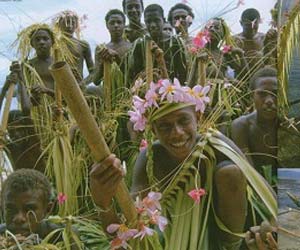I ♥ Island Time!
by Salina Scott
This article was written by a freelance UK journalist who came to the St Andrew’s Day festival with VCT for a holiday. This festival features a custom fishing experience rarely seen in the world.
Clocks are overrated. Unless of course your catching a plane, running late for a meeting or boiling an egg. My days on Mota Lava and its island neighbour Rah existed without the need to know the time, which is just how a holiday should be. There are no clocks anywhere, and no one wears a watch. This is the ultimate in relaxation – welcome to the Banks.
The journey in a small plane is part of the intrepid adventure of getting to this region of Vanuatu. It carries you over multiple lush green islands, surrounded by coral reefs and hypnotic turquoise water. The flights seem more like a sky bus for locals hopping on and off to different islands with various over sized fruits, from melons to pineapples.
As soon as you step off the plane onto Mota Lava friendly locals greet you. It is as clear as their oceans to see that Vanuatu’s main attraction is the islanders. They are the beauty that lies around them personified. Rah Island is a small pocket of beauty off the mainland of Mota Lava and is only 1.7km in radius. It has around 200-250 inhabitants and resembles a textbook paradise. This is where my travel companions and I were staying in beach bungalows. The rooms are basic but fitted with all the essentials – a bed, table, mosquito net, and a hurricane lamp.
We arrived on the Monday and preparations were already underway for the St Andrews Day Festival on the Thursday. The beach was being raked, costumes were being woven and fish were getting caught. They may not be fussed with knowing the time, but Ni-Vans certainly are efficient and resourceful.
The whole village and all its generations get together and use a traditional and unique method of catching large numbers of fish. A 1.2 kilometre long fishing line is made out of palm leaves tied around very long vine. Men, women and small children (known locally as pikininis) drag the fence to the edge of the reef and bring it back to shore forming a “U shape.” The vine rope, which the palm leaves are tied to, is poisonous to the fish, which are trapped inside on display in the shallow water of the reef. The locals seize them with spears, bows and arrows. The process seemed quite laborious to me, but the sense of community was astonishing. Following this spectacle I sat at the shore and gutted our fresh catch with the women of the village.
The St Andrews Day festival kicked off with a church ceremony attended by as many as could fit on the seats inside. The overspill of churchgoers leaned in through the windows to listen to the sermons. The service was spoken in pigeon English and the readings were bridged with gospel singing. The harmonies made the hairs on the back of my neck stand up with their power – they sound awesome! There is absolutely no shortage of food, as after the ceremony we sat and ate fish until our stomachs hurt. While the dancers got ready to entertain, the villagers from Mota Lava and Rah gathered around to watch all generations dance away the afternoon. The dances ended with the famous ‘Snake Dance’ where the men cover themselves in charcoal and ochre and mimic the sea snake of the water. Young and old sat watching, equally amused as each other by the festivities. I looked on, celebrating this breathtaking day.
My time on the island was over too soon and I made my way back to Sydney the day after the festival. But I will without a doubt return to this special region of Vanuatu again, hopefully for another festival. The Ni-vans are onto something measuring life not in minutes, hours and sunsets but in moments like these.
For information on other festivals on Rah Island (including a new Round Island Canoe Race in September), Mota Lava and other hidden parts of Vanuatu see www.vanuatucustomtravel.com or email info@vanuatu.com.au
















